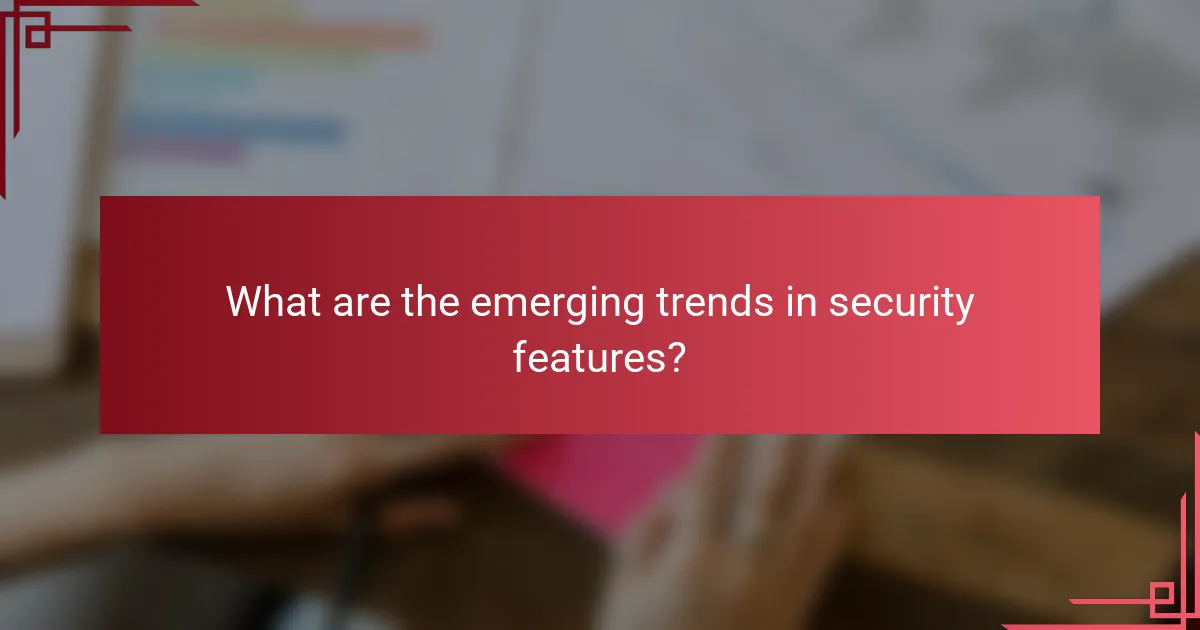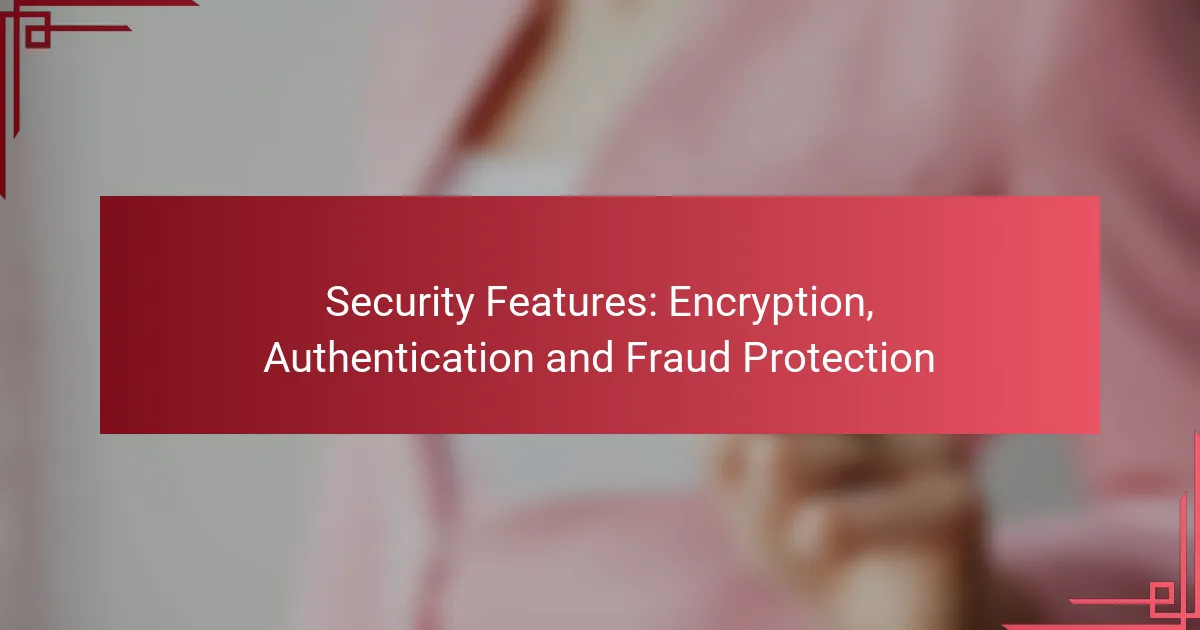In today’s digital landscape, robust security features such as encryption, authentication, and fraud protection are essential for safeguarding sensitive information. Effective encryption methods like AES, RSA, and ECC provide varying levels of security tailored to specific needs, while authentication processes ensure that only verified users gain access to critical systems. Additionally, implementing comprehensive fraud protection strategies, including transaction monitoring and chargeback management, helps businesses mitigate risks and secure their operations against potential threats.

What are the best encryption methods for data security?
The best encryption methods for data security include AES, RSA, and ECC, each offering unique advantages for protecting sensitive information. Choosing the right method depends on the specific requirements, such as speed, security level, and application context.
AES (Advanced Encryption Standard)
AES is a symmetric encryption algorithm widely used for securing data. It operates on fixed block sizes and supports key lengths of 128, 192, or 256 bits, making it suitable for various applications, from file encryption to securing communications.
One of the key benefits of AES is its speed and efficiency, especially in hardware implementations. It is a standard for encrypting sensitive data in compliance with regulations like FIPS 197, making it a reliable choice for businesses and organizations.
RSA (Rivest-Shamir-Adleman)
RSA is an asymmetric encryption algorithm that uses a pair of keys: a public key for encryption and a private key for decryption. This method is commonly used for secure data transmission, digital signatures, and key exchange.
While RSA provides strong security, it is generally slower than symmetric methods like AES, especially with larger key sizes (typically 2048 bits or more). It is crucial to balance security needs with performance requirements when implementing RSA.
ECC (Elliptic Curve Cryptography)
ECC is another form of asymmetric encryption that offers similar security to RSA but with smaller key sizes, making it more efficient. For example, a 256-bit ECC key provides comparable security to a 3072-bit RSA key, resulting in faster computations and reduced storage requirements.
ECC is particularly advantageous for mobile devices and environments with limited processing power. However, its implementation may require a deeper understanding of elliptic curves and their mathematical properties, which can be a barrier for some users.

How does authentication enhance security?
Authentication significantly enhances security by verifying the identity of users before granting access to systems or data. This process helps prevent unauthorized access and protects sensitive information from potential threats.
Multi-Factor Authentication (MFA)
Multi-Factor Authentication (MFA) adds an extra layer of security by requiring users to provide two or more verification factors to gain access. This typically includes something they know (like a password), something they have (like a smartphone), or something they are (like a fingerprint).
MFA is effective because even if a password is compromised, unauthorized users would still need the additional factors to access the account. Common implementations include SMS codes, authentication apps, or biometric scans.
To implement MFA, ensure that your system supports it and encourage users to enroll. Avoid relying solely on SMS for verification, as it can be vulnerable to interception.
Single Sign-On (SSO)
Single Sign-On (SSO) simplifies the user experience by allowing individuals to access multiple applications with one set of login credentials. This reduces the number of passwords users need to remember and can enhance security by minimizing password fatigue.
While SSO can streamline access, it also centralizes authentication, which means that if an SSO account is compromised, all linked applications may be at risk. It’s crucial to implement strong security measures for the SSO account itself, such as MFA.
When considering SSO, evaluate the security protocols of the SSO provider and ensure they comply with relevant regulations. Regularly review access permissions to maintain security across all connected applications.

What fraud protection measures should businesses implement?
Businesses should implement a combination of transaction monitoring, chargeback management, and robust authentication methods to effectively protect against fraud. These measures help identify suspicious activities, manage disputes, and ensure secure transactions.
Transaction Monitoring
Transaction monitoring involves continuously analyzing transactions for unusual patterns or behaviors that may indicate fraud. This process typically uses algorithms and machine learning to flag transactions that deviate from a customer’s normal spending habits.
Businesses should set thresholds for alerts based on transaction size, frequency, and geographic location. For example, a sudden large purchase from a different country could trigger an alert for further investigation. Regularly reviewing and adjusting these parameters can enhance detection capabilities.
Chargeback Management
Chargeback management is crucial for minimizing losses from fraudulent transactions. This process includes tracking chargebacks, analyzing their causes, and implementing strategies to reduce their occurrence. Effective management can help businesses maintain better relationships with payment processors and avoid penalties.
Businesses should establish a clear policy for handling chargebacks, including timelines for responses and documentation requirements. Educating customers about the return process can also reduce the likelihood of chargebacks stemming from misunderstandings. Regularly reviewing chargeback data can provide insights into potential vulnerabilities in the sales process.

What are the compliance requirements for encryption and authentication?
Compliance requirements for encryption and authentication vary by regulation but generally focus on protecting sensitive data and ensuring secure access. Organizations must implement specific measures to meet these standards, which can include encryption protocols, user authentication mechanisms, and regular audits.
GDPR (General Data Protection Regulation)
The GDPR mandates that personal data must be processed securely using appropriate technical measures, including encryption. Organizations handling EU citizens’ data must ensure that any data breaches are reported within 72 hours and that data is protected against unauthorized access.
To comply with GDPR, businesses should implement strong encryption methods for data at rest and in transit. Regularly reviewing access controls and conducting security assessments can help maintain compliance and protect personal data effectively.
PCI DSS (Payment Card Industry Data Security Standard)
PCI DSS requires organizations that handle credit card information to implement robust encryption and authentication measures. This includes encrypting cardholder data during transmission and ensuring that only authorized personnel can access sensitive information.
To meet PCI DSS requirements, businesses should use strong encryption protocols like AES-256 and regularly update their security systems. Conducting vulnerability scans and maintaining a secure network infrastructure are also essential steps to ensure compliance.

How to choose the right security features for your business?
Choosing the right security features for your business involves understanding your specific needs and the potential risks you face. Focus on essential elements like encryption, authentication, and fraud protection to safeguard sensitive data effectively.
Assessing Business Needs
Start by identifying the types of data your business handles and the potential threats associated with that data. For instance, if you manage customer financial information, robust encryption and strong authentication methods are crucial.
Consider the scale of your operations and the regulatory requirements relevant to your industry. Businesses in finance or healthcare may need to comply with stricter standards, such as PCI DSS or HIPAA, which dictate specific security measures.
Evaluating Vendor Solutions
When evaluating vendor solutions, compare their security features against your assessed needs. Look for providers that offer comprehensive encryption methods, multi-factor authentication, and proactive fraud detection tools.
Check for compliance with industry standards and certifications, as these can indicate a vendor’s commitment to security. Additionally, consider the vendor’s reputation and customer reviews to gauge their reliability and support services.

What are the emerging trends in security features?
Emerging trends in security features focus on enhancing protection through advanced technologies and methodologies. Key developments include the adoption of Zero Trust security models and the integration of artificial intelligence in fraud detection.
Zero Trust Security Model
The Zero Trust security model operates on the principle of “never trust, always verify.” This approach requires strict identity verification for every user and device attempting to access resources, regardless of whether they are inside or outside the network perimeter.
Implementing Zero Trust involves several key steps, such as continuous monitoring, enforcing least privilege access, and utilizing multi-factor authentication. Organizations should assess their current security posture and gradually adopt Zero Trust principles to enhance their defenses against potential breaches.
Common pitfalls include underestimating the complexity of implementation and failing to educate employees about new protocols. Regular training and clear communication can help mitigate these challenges.
AI in Fraud Detection
Artificial intelligence is increasingly being utilized in fraud detection to analyze patterns and identify anomalies in real-time. AI systems can process vast amounts of data quickly, making them effective in spotting fraudulent activities that traditional methods might miss.
Key considerations for implementing AI in fraud detection include selecting the right algorithms and ensuring data quality. Organizations should also be aware of the potential for false positives and continuously refine their models based on feedback and evolving threats.
To maximize effectiveness, companies should combine AI with human oversight, leveraging both technology and expert judgment. Regularly updating AI systems and incorporating new data sources can further enhance their accuracy and reliability in detecting fraud.
